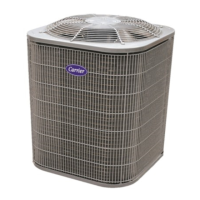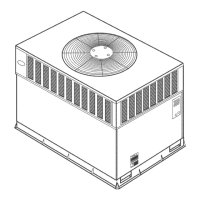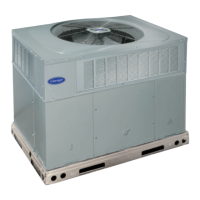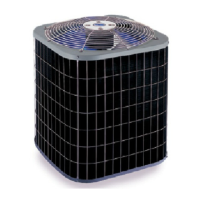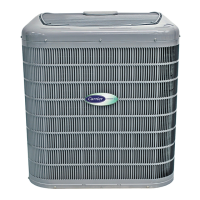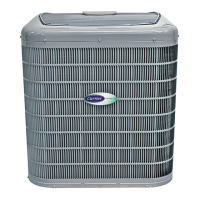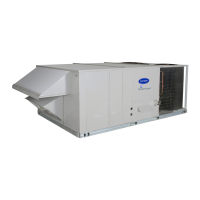37
Shorted or mis--wiring of the low voltage motor harness wiring
will not cause damage to ECM board or to motor Control Module.
If the MOTOR LED is off, STATUS LED is indicating a Status
Code 44 and motor is running:
Disconnect the motor harness at the ECM board. If motor
continues to run, ECM board is good and Control Module on
motor may need replacement.
STATUS CODE 2 5, INVALID MOTOR / MODEL
SELECTION:
On initial start--up, ECM board shall poll motor for its size data and
check blower size data stored in ECM board memory.
1. If motor size or ECM board data doesn ’t match, Status
Code 25 will be displayed on STATUS LED.
2. If model size data is missing (as is the case when a replace-
ment ECM board is installed), system User Interface will
prompt installer to enter correct model size from a list of
valid sizes.
3. If motor size is incorrect for model size, motor must be re-
placed with proper size motor. ECM board will not re-
spond to operation requests until this fault condition is
resolved.
STATUS CODE 27, INVALID OUTDOOR UNIT SIZE:
On initial power--up, ECM board will write into memory UPM
information as provided by User Interface in a fully
communicating system.
1. If UPM board data is invalid, Status Code 27 will be dis-
played on ST ATUS LED.
2. User Interface will prompt the installer to choose system
size from a list of valid sizes for application with blower.
3. Check communications wiring to be sure User Interface has
established communications with outdoor unit or select
proper size from valid size list provided at User Interface.
4. Check motor and motor Control Module following the in-
structions in Section C. ECM Motor Troubleshooting.
STATUS CODE 26, INVALID HEATER SIZE:
On initial power--up, ECM board will write into memory electric
heater size as read from heater. The heater is provided with
Identifier Resistor (IDR). Heater size must be valid for combination
of indoor and outdoor components installed. ECM board will read
IDR value connected to pins 5 and 8 of heater harness connector. If
no resistor is found, system User Interface will prompt installer to
verify that no heater is installed. Verifying that this is correct will
establish that blower is operating without an electric heater
accessory. Upon choosing negative option, installer will be
prompted to select heater size installed from a list of valid heater
sizes for blower and UPM data size installed. If heater ID resistor
value read is invalid, Status Code 26 will be displayed on STATUS
LED. If heater installed is equipped with a resistor connected to
pins 5 and 8 of heater harness connector and Status Code 26 is
displayed on STATUS LED:
1. Check wiring harness connections to be sure connections
are secure.
2. If symptoms persist, disconnect wiring harness at ECM
board heater header and check for a resistance value greater
than 5000 ohms.
3. Check for proper wiring of resistor assembly .
4. Make sure heater size installed is an approved size for out-
door unit and blower sizes installed.
NOTE: ECM board will not operate electric heater until this
Status Code is resolved. If the heater size is set through the User
Interface, the heater will be operated as a single stage heater. If
staging is desired, the IDR value must be read in by the ECM
board.
STATUS CODE 36, HEATER OUTPUT NOT SENSED
WHEN ENERGIZED:
ECM board is provided with circuitry to detect presence of a
24VAC signal on Electric Heater stage 1 and stage 2 outputs. If
ECM board energizes either heater stage and does not detect the
24VAC signal on output, Status Code 36 will be displayed on the
STATUS LED ECM board will continue to energize heater
output(s) and adjust blower operation to a safe airflow level for
energized electric heat stage(s).
To find the fault:
Check for 24VAC on heater stage outputs. ECM board or sensing
circuit may be bad.
NOTE: It may be useful as an electric heater troubleshooting
procedure to disconnect the system communications to force Status
Code 16 enabling of emergency heat mode. It is difficult to know
which heater output is energized or not energized in normal
operation. When blower is operated in emergency heat mode using
electric heaters, both outputs are energized and de--energized
together. Terminal strip inputs to control can then be connected R
to W to turn on both electric heat outputs. Heater output sensing
circuits can then be checked to resolve Status Code 36 or 37
problems.
STATUS CODE 41, BLOWER MOTOR FAULT:
If MOTOR LED is lit and flashing and motor does not run:
1. Check ST ATUS LED. If STATUS LED is indicating Status
Code 41, motor control has detected that the motor will not
come up to speed within 30 seconds of being commanded
to run or that the motor has been slowed to below 250 rpm
for more than 10 seconds after coming up to speed. Motor
wiring harness and ECM board are operating properly, do
not replace.
2. Check to be sure that the blower wheel is not rubbing the
housing.
3. Check motor to b e sure that the motor shaft is not seized
(motor Control Module must be removed and electronics
disconnected from windings to perform this check proper-
ly).
4. Check motor windings section following instructions in
Section C. ECM Motor Troubleshooting.
If all these checks are normal, the motor Control Module may need
replacement.
STATUS CODE 16, SYSTEM COMMUNICATION FAULT:
On initial power--up and at any time system communications are
not successful for a period exceeding 2 minutes following
successful communications, the ECM board will only allow
emergency heating or cooling operation using a common
thermostat, wired to both UPM and ECM boards
non-- communicating thermostat connections RGWYO and will
display Status code 16 on the amber STATUS LED (see
Emergency Heating and Cooling Modes). No further blower
troubleshooting information will be available at the User Interface
until communications are reestablished.
Check system wiring to be sure the User Interface is powered and
connections are made A to A, B to B, etc. and wiring is not
shorted. Mis--wiring or shorting of the ABCD communications
wiring will not allow successful communications. Correcting
wiring faults will clear the code and reestablish communications.
Shorting or mis--wiring the low voltage system wiring will not
cause damage to ECM board or to User Interface but may cause the
low voltage fuse to open.
